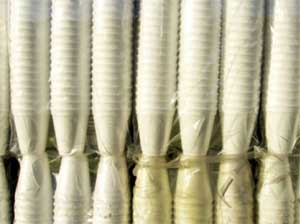- Home
- Editorial
- News
- Practice Guidelines
- Anesthesiology Guidelines
- Cancer Guidelines
- Cardiac Sciences Guidelines
- Critical Care Guidelines
- Dentistry Guidelines
- Dermatology Guidelines
- Diabetes and Endo Guidelines
- Diagnostics Guidelines
- ENT Guidelines
- Featured Practice Guidelines
- Gastroenterology Guidelines
- Geriatrics Guidelines
- Medicine Guidelines
- Nephrology Guidelines
- Neurosciences Guidelines
- Obs and Gynae Guidelines
- Ophthalmology Guidelines
- Orthopaedics Guidelines
- Paediatrics Guidelines
- Psychiatry Guidelines
- Pulmonology Guidelines
- Radiology Guidelines
- Surgery Guidelines
- Urology Guidelines
Styrene linked to increased risk of acute myeloid leukemia

Another important research result is a fivefold risk for a particular type of nasal cancer following styrene exposure. This part of the study is published in Occupational and Environmental Medicine in the article 'Sinonasal adenocarcinoma following styrene exposure in the reinforced plastics industry'.
In March, the 23 researchers in the WHO working group spent ten intensive working days in Lyon, where they had the task of reviewing and re-evaluating the carcinogenic risk based on the latest research on styrene exposure which includes epidemiological studies of humans together with animal experiments and what are known as mechanism studies. The latter cover cause-effect studies based on the biological material.
The issue of styrene and cancer has been a priority for IARC ever since an accumulation of leukemia cases among employees in the American synthetic rubber industry was seen in the 1970s. However, it was not possible to establish whether the American workers contracted leukemia from handling styrene or from butadiene, a chemical, which is styrene's permanent companion in the production of synthetic rubber - and this is where the Danish register-based studies come into the picture.
"Clearly, the best place to study the possible health effects of styrene exposure is in the reinforced plastics industry, where no butadiene is involved. We have therefore mapped the cancer incidence for those who worked in companies that used styrene in the production during the period 1968-2011," explains Henrik Kolstad on the background for what has ended up being the world's largest epidemiological study of styrene exposure in the reinforced plastics industry.
In the research project, Ph.D. student Mette Skovgaard Christensen, Henrik Kolstad and their research colleagues followed 73,036 employees who during the period 1968-2011 worked in one of the 456 small and medium-sized companies in Denmark that have used styrene in the production of e.g. wind turbines or yachts.
The study has involved a comprehensive linkage of registers, where the researchers used the central business register, along with various other company registers, to identify the relevant companies and their employees. After this stage, the information was linked with the Danish Cancer Register to assess the incidences of different types of cancer among the employees compared to the general population's risk of developing the same diseases.
One of the reasons why the results carry a lot of weight with the WHO is that Kolstad and his colleagues have been able to compare the research data from the cancer patients with measurements of styrene exposure in the Danish reinforced plastics industry over time.
"That part of the study is primarily based on measurements that the Danish Working Environment Authority carried out a number of years ago since the Danish Working Environment Authority has not carried out measurements of styrene over the past several years. Many companies take measurements, but they are not publicly available. We've requested the relevant data in an anonymized form from the companies that analyze the measurements, but unfortunately, we were unable to gain access to them," says Henrik Kolstad
"This is deeply regrettable because the fact is that good answers to important questions presuppose that we also have access to the relevant information in the future."
Henrik Kolstad emphasizes that the Danish register findings reflect the sins of the past. Significant improvements have been made to the working environments in the Danish reinforced plastics industry in recent years, but globally the problem has not been solved.
For further information click on the link: 10.1097/EDE.0000000000000819

Disclaimer: This site is primarily intended for healthcare professionals. Any content/information on this website does not replace the advice of medical and/or health professionals and should not be construed as medical/diagnostic advice/endorsement or prescription. Use of this site is subject to our terms of use, privacy policy, advertisement policy. © 2020 Minerva Medical Treatment Pvt Ltd